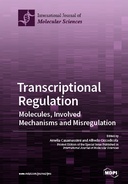Explore

Transcriptional Regulation: Molecules, Involved Mechanisms and Misregulation
Amelia Casamassimi and Alfredo Ciccodicola
2019
0 Ungluers have
Faved this Work
Login to Fave
Transcriptional regulation is a critical biological process involved in the response of a cell, a tissue or an organism to a variety of intra- and extra-cellular signals. Besides, it controls the establishment and maintenance of cell identity throughout developmental and differentiation programs. This highly complex and dynamic process is orchestrated by a huge number of molecules and protein networks and occurs through multiple temporal and functional steps. Of note, many human disorders are characterized by misregulation of global transcription since most of the signaling pathways ultimately target components of transcription machinery. This book includes a selection of papers that illustrate recent advances in our understanding of transcriptional regulation and focuses on many important topics, from cis-regulatory elements to transcription factors, chromatin regulators and non-coding RNAs, other than several transcriptome studies and computational analyses.
This book is included in DOAB.
Why read this book? Have your say.
You must be logged in to comment.
Rights Information
Are you the author or publisher of this work? If so, you can claim it as yours by registering as an Unglue.it rights holder.Downloads
This work has been downloaded 531 times via unglue.it ebook links.
- 220 - pdf (CC BY-NC-ND) at Unglue.it.
Keywords
- 1798)
- acute leukemia
- adenosine and uridine-rich elements (AREs)
- adiponectin
- Adiponectin receptors
- Akt1
- and drug design
- AP-2?
- bioadhesive
- Bioinformatics
- Cancer
- causal inference
- CDKN1C
- Cell Differentiation
- cell metabolism
- circRNA-disease associations
- common pathway
- Crassostrea gigas
- CRISPR/Cas9
- Cytogenetics
- differentially expressed genes
- Disease
- disorders
- enhancer activity
- epigenetics
- fertilization
- FOXO1
- G-quadruplex
- Gene expression
- Glioblastoma
- heterogeneous network
- high-throughput RNA sequencing (RNA-Seq)
- Human
- human malignancies
- Inflammation
- inflammatory response
- insect
- Interactome
- liquid chromatograph-tandem mass spectrometer (LC-MS/MS)
- long non-coding RNA (lncRNA)
- long non-coding RNAs
- Major Depressive Disorder
- mechanisms
- melanin
- Microscopy
- miR-25-3p
- molecular docking
- molecular pathways
- mouse
- N-acyl-l-homoserine lactone
- n/a
- nonsense-mediated decay
- Novosphingobium pentaromativorans US6-1
- Nutrition
- nutritional status
- Obesity
- p57Kip2
- Pacific oyster
- Patau Syndrome
- pathway
- Pax3
- pediveliger larvae
- Placenta
- posttranscriptional regulation
- ppGpp
- PRDM gene family
- Pregnancy
- progress and prospects
- Promoter
- Pteria penguin (Röding
- Pteria penguin (Röding, 1798)
- Research methods
- RNA interference
- RNA-Seq
- Rsh regulon
- selenium
- selenocysteine
- selenocysteine insertion sequence
- selenoproteins
- self-incompatibility
- somatic mutations
- sphingomonads
- structures and functions
- TCGA data analysis
- Tea
- therapeutic targets
- transcription
- transcription factor
- Transcription Factors
- Transcription Regulation
- transcriptional regulation
- transcriptome
- transcriptome profiling
- Transcriptomics
- tristetraprolin (TTP)
- tumorigenesis
- tyrosinase
Links
DOI: 10.3390/books978-3-03921-266-8Editions


